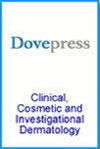使用 5 -氨基乙酰丙酸 (ALA) 负载丙烯酸纳米颗粒 (ANPs) 进行光动力疗法对 HaCaT 细胞的影响
IF 2.2
4区 医学
Q3 DERMATOLOGY
引用次数: 0
摘要
目的:ALA-PDT(5-氨基乙酰丙酸光动力疗法)是治疗皮肤病的核心方法。提高 ALA 的生物利用率仍是一个关键问题。有鉴于此,我们的研究探索了一种通过负载丙烯酸纳米颗粒(ANPs)输送 ALA 的新途径:通过乳液聚合合成了 ALA-ANPs,并用扫描电子显微镜(SEM)、透射电子显微镜(TEM)和纳米粒子跟踪分析(NTA)对其进行了表征。评估了 ALA-ANPs 对 HaCaT 细胞系的影响,包括这些细胞的特征、形态变化、原卟啉 IX(PpIX)荧光动力学、活性氧(ROS)水平、线粒体膜电位和 ki67 表达:ANPs大小均匀,表面光滑,透光性极佳,直径为150-200纳米。相比之下,ALA - ANP 表面不平滑,透光性差,直径为 220- 250 nm。在 HaCaT 细胞与 ALA 共同培养 12 小时期间,PpIX 在细胞内的积累随着时间的推移而增加。值得注意的是,培养 6 小时后,1.81 mg/mL ALA-ANPs 诱导的 PpIX 水平超过了 1.0 mM ALA 诱导的水平(p < 0.01)。CCK-8 结果显示,当 ALA 浓度低于 2.0 mM 时,PDT 诱导的 HaCaT 细胞增殖抑制与 ALA 浓度呈正相关。与 1.0 mM ALA 组相比,1.81 mg/mL ALA-ANPs 组的线粒体膜电位、ki67 免疫荧光强度和细胞增殖均有所下降。相比之下,1.81 mg/mL ALA-ANPs 组的 ROS 水平明显升高(p < 0.01):结论:负载 ANPs 提高了 ALA 的稳定性和效力。ALA-ANPs-PDT方法在体外对HaCaT增殖有较好的抑制作用:5-氨基苯戊酸 ALA 丙烯酸酯纳米孔 光动力疗法本文章由计算机程序翻译,如有差异,请以英文原文为准。
Effects of Photodynamic Therapy Using 5 -Aminolevulinic Acid (ALA) Loaded Acrylic Nanoparticles (ANPs) on HaCaT Cells
Objective: ALA-PDT (5-aminolevulinic acid photodynamic therapy) is a central modality in the treatment of skin diseases. Increasing the bioavailability of ALA remains a critical issue. With this in mind, our study explores a novel route of ALA delivery by loading acrylic nanoparticles (ANPs).
Methods: ALA-ANPs were synthesized by emulsion polymerisation and characterised by scanning electron microscopy (SEM), transmission electron microscopy (TEM) and nanoparticle tracking analysis (NTA). The effects of ALA-ANPs on HaCaT cell line were evaluated, including characteristics, morphological changes, protoporphyrin IX (PpIX) fluorescence kinetics, reactive oxygen species (ROS) levels, mitochondrial membrane potential and ki67 expression in these cells.
Results: The ANPs had uniform sizes, smooth surfaces and excellent light transmittance, with diameters of 150– 200 nm. In contrast, the ALA - ANPs had uneven surfaces and poor light transmittance, with diameters of 220– 250 nm. During 12 hours of co-incubation of HaCaT cells with ALA, the intracellular accumulation of PpIX increased over time. Notably, after 6 hours of incubation, PpIX levels induced by 1.81 mg/mL ALA-ANPs exceeded those induced by 1.0 mM ALA (p < 0.01). CCK-8 results showed a positive correlation between PDT-induced inhibition of HaCaT cell proliferation and ALA concentration when ALA concentration remained below 2.0 mM. Compared to the 1.0 mM ALA group, the 1.81 mg/mL ALA-ANPs group showed decreased mitochondrial membrane potential, ki67 immunofluorescence intensity and cell proliferation. In contrast, ROS levels were significantly increased in the 1.81 mg/mL ALA-ANPs group (p < 0.01).
Conclusion: Loading ANPs provide improved stability and potency for ALA. The ALA-ANPs-PDT approach has superior inhibitory effects on HaCaT proliferation in vitro.
Keywords: 5-aminophenolvalic acid, ALA, acrylate nanoporous, photodynamic therapy
Methods: ALA-ANPs were synthesized by emulsion polymerisation and characterised by scanning electron microscopy (SEM), transmission electron microscopy (TEM) and nanoparticle tracking analysis (NTA). The effects of ALA-ANPs on HaCaT cell line were evaluated, including characteristics, morphological changes, protoporphyrin IX (PpIX) fluorescence kinetics, reactive oxygen species (ROS) levels, mitochondrial membrane potential and ki67 expression in these cells.
Results: The ANPs had uniform sizes, smooth surfaces and excellent light transmittance, with diameters of 150– 200 nm. In contrast, the ALA - ANPs had uneven surfaces and poor light transmittance, with diameters of 220– 250 nm. During 12 hours of co-incubation of HaCaT cells with ALA, the intracellular accumulation of PpIX increased over time. Notably, after 6 hours of incubation, PpIX levels induced by 1.81 mg/mL ALA-ANPs exceeded those induced by 1.0 mM ALA (p < 0.01). CCK-8 results showed a positive correlation between PDT-induced inhibition of HaCaT cell proliferation and ALA concentration when ALA concentration remained below 2.0 mM. Compared to the 1.0 mM ALA group, the 1.81 mg/mL ALA-ANPs group showed decreased mitochondrial membrane potential, ki67 immunofluorescence intensity and cell proliferation. In contrast, ROS levels were significantly increased in the 1.81 mg/mL ALA-ANPs group (p < 0.01).
Conclusion: Loading ANPs provide improved stability and potency for ALA. The ALA-ANPs-PDT approach has superior inhibitory effects on HaCaT proliferation in vitro.
Keywords: 5-aminophenolvalic acid, ALA, acrylate nanoporous, photodynamic therapy
求助全文
通过发布文献求助,成功后即可免费获取论文全文。
去求助
来源期刊

Clinical, Cosmetic and Investigational Dermatology
Medicine-Dermatology
CiteScore
2.80
自引率
4.30%
发文量
353
审稿时长
16 weeks
期刊介绍:
Clinical, Cosmetic and Investigational Dermatology is an international, peer-reviewed, open access journal that focuses on the latest clinical and experimental research in all aspects of skin disease and cosmetic interventions. Normal and pathological processes in skin development and aging, their modification and treatment, as well as basic research into histology of dermal and dermal structures that provide clinical insights and potential treatment options are key topics for the journal.
Patient satisfaction, preference, quality of life, compliance, persistence and their role in developing new management options to optimize outcomes for target conditions constitute major areas of interest.
The journal is characterized by the rapid reporting of clinical studies, reviews and original research in skin research and skin care.
All areas of dermatology will be covered; contributions will be welcomed from all clinicians and basic science researchers globally.
 求助内容:
求助内容: 应助结果提醒方式:
应助结果提醒方式:


